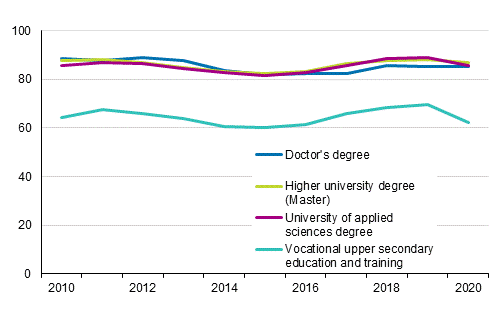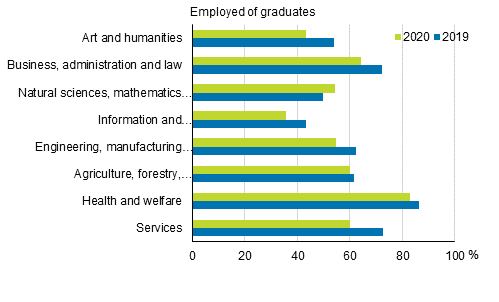Published: 20 January 2022
Employment of recent graduates with initial vocational qualifications weakened by 8 percentage points
According to Statistics Finland's education statistics, employment became more difficult for recent graduates with initial vocational qualifications in 2020. Sixty-two per cent of them were employed in the following year after graduation. Especially those graduating from services had more difficulties in finding employment during the coronavirus year than one year before.
Employment of graduates one year after graduation 2010–2020, %

Employment among recent graduates is measured one year after their graduation. Employment of all recent graduates weakened by five percentage points. Of them, 68 per cent were working one year after graduation, 54 per cent full-time and 14 per cent were working besides studies. The share of those working full-time had diminished by four percentage points from the previous year. The proportion of the unemployed was 11 per cent.
Of those with initial vocational qualifications, 62 per cent were employed, 69 per cent of women and 55 per cent of men. In all, 20 per cent were unemployed, 15 per cent of women and 25 per cent of men. After initial vocational qualifications, 17 per cent continued studying, eight per cent of them while working. Of women, 11 per cent continued studying alongside work and of men six per cent. Twelve per cent of men were in the group others, which includes non-military and military service, for example.
Employment of graduates with initial vocational qualification by field of education 2019 and 2020, %

Finding employment became most difficult for those with initial vocational qualifications in services, 12 percentage points. In services, 60 per cent of graduates found employment. Finding employment was easiest for those with initial vocational qualifications in the field of health and welfare, of whom 83 per cent were employed. Employment was found second most successfully by those with qualifications in the field of business, administration and law, 64 per cent of whom were employed. Employment was weakest among those with qualifications in information and communication technology (ICT), of whom only 36 per cent found employment, the drop from the previous year amounted to eight percentage points. The fields of education with the highest numbers of qualifications were technology, health and welfare, and services. Employment of those with initial vocational qualifications in the field of technology decreased by seven percentage points, 55 per cent of them were employed in 2020.
Eighty-one per cent of those with vocational qualifications had found employment after one year and 90 per cent of those with specialist vocational qualifications had found employment. Employment decreased by four percentage points in both levels of education.
The majority of those having passed the matriculation examination were continuing studies one year later, although 37 per cent of passers of the matriculation examination in spring 2020 continued studies immediately after the matriculation examination, see Entrance to education . One year after the matriculation examination, 56 per cent of passers of the matriculation examination continued studies, 60 per cent of women and 52 per cent of men. In addition to further studies, 16 per cent were working, 20 per cent of women and 10 per cent of men.
In all, 86 per cent of those with university of applied sciences degrees had found employment within one year and 93 per cent of those with higher university of applied sciences degrees. Eight per cent of those with university of applied sciences degrees were unemployed, which is three percentage points more than in the year before. Employment of those with master's degrees weakened only by one percentage point. Eighty-seven per cent of them found employment. Of recently graduated doctors, 85 per cent were working, 86 per cent of women and 84 per cent of men. The share of the unemployed was five per cent.
In most university education, the right to study is for master's degree. For that reason, the majority of recent graduates with bachelors's degrees continued studies (90 per cent). Over one half were also working while studying (53 per cent).
More detailed information on the employment of recent graduates by region of residence, age, level and field of education can be found in the database tables .
Source: Education 2021. Statistics Finland
Inquiries: Anna Loukkola 029 551 3678, koulutustilastot@stat.fi
Head of Department in charge: Hannele Orjala
Publication in pdf-format (218.1 kB)
- Tables
-
Tables in databases
Pick the data you need into tables, view the data as graphs, or download the data for your use.
Appendix tables
Updated 20.1.2022
Official Statistics of Finland (OSF):
Transition from school to further education and work [e-publication].
ISSN=1798-9469. 2020. Helsinki: Statistics Finland [referred: 5.1.2026].
Access method: http://stat.fi/til/sijk/2020/sijk_2020_2022-01-20_tie_001_en.html

